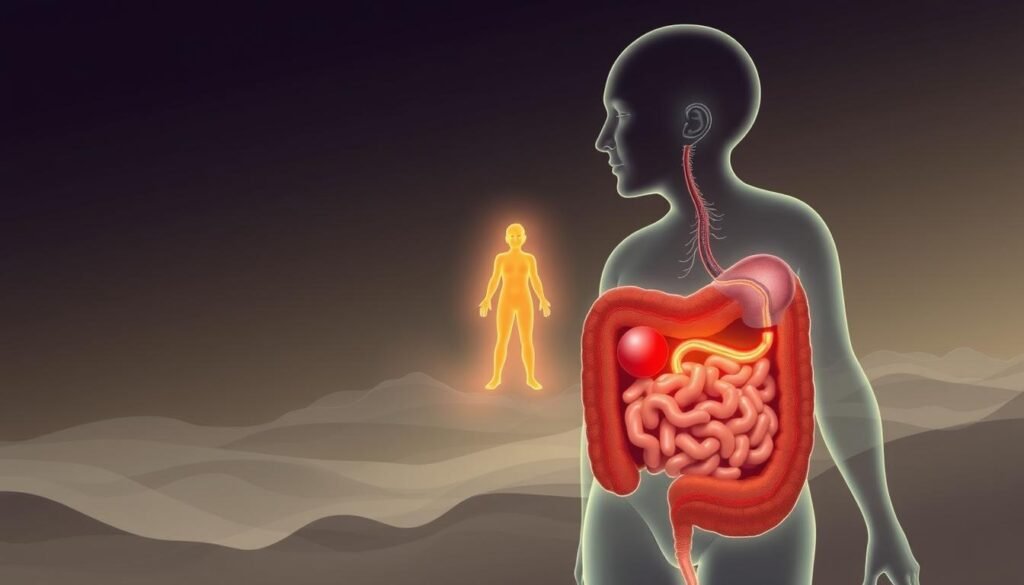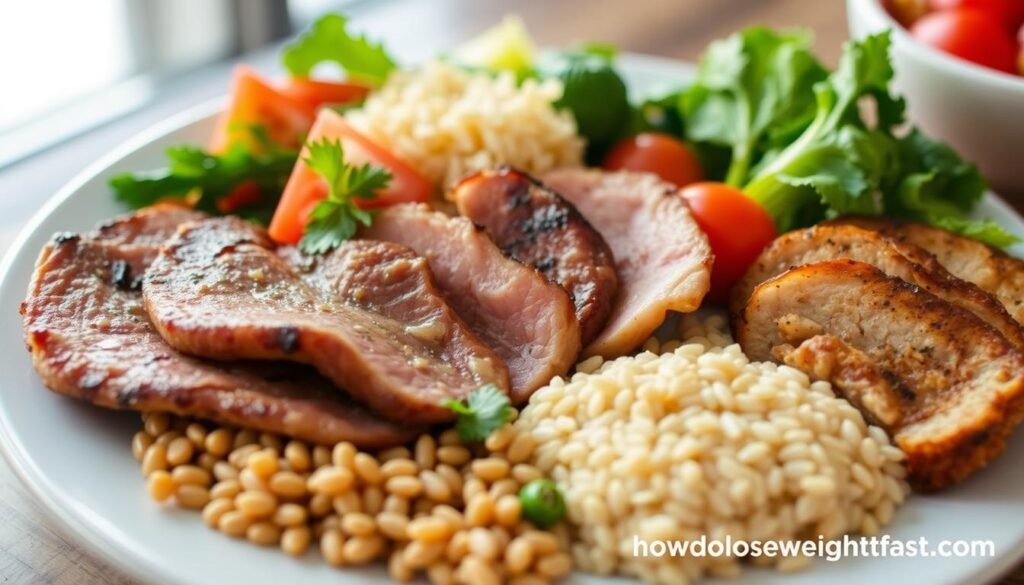Proven Strategies to Lose Stubborn Belly Fat After 40
Sarah never worried about her waistline until her 43rd birthday. Despite weekly yoga classes and salad lunches, she noticed her favorite jeans fitting tighter each month. Like many Americans entering their fifth decade, she discovered her body wasn’t responding to old habits the way it used to.
That stubborn abdominal weight isn’t just about appearance. Deep visceral fat wraps around vital organs, releasing inflammatory compounds that increase risks for diabetes and heart disease. While subcutaneous fat (the pinchable kind) poses cosmetic concerns, it’s the hidden internal fat that demands urgent attention.
Midlife brings unique challenges – hormonal shifts can redistribute fat storage while slowing metabolism by 3-5% per decade. Crash diets often backfire, causing muscle loss that worsens the problem. Lasting solutions require understanding these biological changes and adapting strategies accordingly.
Key Takeaways
- Metabolism naturally slows 3-5% per decade after 40
- Visceral fat poses greater health risks than surface fat
- Hormonal changes affect fat storage patterns
- 16 science-backed methods address age-related challenges
- Lifestyle changes outperform temporary diets
- Holistic approach combines nutrition, movement, and recovery
- Progress tracking ensures sustainable results
Understanding Belly Fat and Its Health Implications
Your body stores two distinct types of abdominal fat, and one acts like a silent saboteur. While you might notice soft layers under your skin, the real trouble brews deeper. This hidden fat impacts your health in ways that often go unnoticed until problems arise.
What Is Visceral Fat?
Visceral fat wraps around your internal organs like a toxic blanket. Unlike subcutaneous fat (the jiggly layer you can pinch), this deeper adipose tissue accounts for just 10% of total body fat. But its location near vital organs makes it far more dangerous.
| Type | Location | Health Impact |
|---|---|---|
| Visceral | Around organs | Releases inflammatory chemicals |
| Subcutaneous | Under skin | Mostly energy storage |
This active fat produces hormones that disrupt insulin function and increase blood pressure. Even slim individuals can carry dangerous amounts, making waist measurements crucial. A tape measure often reveals more than the scale.
Long-Term Health Risks
Excess visceral fat triples your risk for type 2 diabetes and heart disease. It’s linked to liver issues and hormonal imbalances in men. Women face increased breast cancer risks from related inflammation.
Simple tracking methods help monitor progress:
- Measure waist at belly button level
- Aim under 35″ (women) or 40″ (men)
- Consider professional scans for accuracy
Why Belly Fat Becomes More Challenging After 40
Reaching your 40s often brings unexpected shifts in how your body handles energy. Biological changes work like invisible architects, reshaping where and how you store fat. These transformations explain why previous strategies might feel less effective now.

Hormonal Changes and Metabolism
Testosterone and estrogen levels naturally decline, altering fat storage patterns. Men may notice more fat around their midsection as testosterone drops. Women often see shifts post-menopause as estrogen decreases.
Your metabolic rate slows by 2-5% each decade after 30. This means burning 50-100 fewer daily calories at rest compared to your 30s. Combined with muscle loss (3-8% per decade), your body becomes less efficient at processing energy.
The Impact of Aging on Fat Distribution
Insulin resistance often increases with age, making cells less responsive to glucose. Excess sugar gets stored as abdominal fat instead of being used for energy. Stress hormones like cortisol amplify this effect, especially during busy career years.
| Factor | Before 40 | After 40 |
|---|---|---|
| Muscle Mass | Stable | Declines 1% yearly |
| Sleep Quality | Deep cycles | Frequent disruptions |
| Fat Storage | Even distribution | Abdominal focus |
Sleep disturbances become common, altering hunger hormones like leptin and ghrelin. This double whammy increases cravings while reducing energy expenditure. Though challenging, understanding these changes helps create effective counter-strategies.
Balanced Diet for Losing Belly Fat
What if your plate holds the key to reshaping your midsection? Nutrition plays a starring role in managing abdominal weight, especially when combined with smart lifestyle choices. Let’s explore two powerful dietary approaches that work with your body’s changing needs.

High Protein Diet and Appetite Control
Protein acts like a triple threat against unwanted weight. It boosts calorie burning by 20-30% during digestion through the thermic effect. Those grilled chicken breasts or lentil stews also trigger peptide YY – a hormone that tells your brain “I’m full!”
Aim for 0.8-1.2 grams of protein per pound daily. Spread intake across meals to maintain muscle while shedding fat. Top sources include:
- Wild-caught fish like salmon
- Pasture-raised eggs
- Greek yogurt
- Plant-based options like tempeh
Nutrient-Dense Foods
Combine proteins with colorful vegetables and healthy fats for maximum impact. Spinach, berries, and avocado provide vitamins that support metabolism. Research shows that focusing on whole foods reduces visceral fat risks better than restrictive diets.
Try this simple formula: fill half your plate with non-starchy veggies, one-quarter with lean protein, and the rest with complex carbs like quinoa. Meal prepping ensures you always have balanced options, even during hectic weeks.
Smart Calorie Management and Portion Control
Ever wonder why some people eat freely while others count every bite? The secret lies in strategic energy balance. Managing intake doesn’t mean deprivation – it’s about working smarter with your body’s changing needs.
Calorie Deficit Strategies
Start by finding your maintenance number – the calories needed to maintain current weight. Online calculators consider age, height, and activity level. Subtract 300-500 calories daily for gradual progress that preserves muscle.
Try these practical methods:
- Use palm-sized portions for proteins
- Fill half your plate with vegetables first
- Choose broth-based soups before meals
Food tracking apps reveal hidden patterns. One study found users lost 3x more weight than non-trackers. Focus on calorie-dense foods like nuts sparingly – a handful contains 200+ calories.
| Activity Level | Calories/Day |
|---|---|
| Sedentary | 1,600-1,800 |
| Active | 2,000-2,200 |
Allow flexibility for special occasions. Enjoy that slice of birthday cake, then balance it with lighter meals later. Your body responds best to consistency, not perfection.
Top Foods to Lose Belly Fat
Your kitchen holds powerful tools for reshaping your midsection. Certain ingredients work like natural allies, helping manage hunger and improve metabolic function. Let’s explore two key categories that make meal planning both effective and enjoyable.
Soluble Fiber and Gut-Friendly Options
Soluble fiber transforms into a gel during digestion, slowing food movement and keeping you satisfied longer. Oats, black beans, and citrus fruits top the list. Research shows adding 10 grams daily could reduce abdominal weight gain by nearly 4% over five years.
| Food | Serving Size | Fiber (grams) |
|---|---|---|
| Lentils | 1 cup cooked | 15.6 |
| Avocado | ½ medium | 6.7 |
| Brussels Sprouts | 1 cup raw | 4.1 |
Fermented foods like kimchi and kefir introduce beneficial bacteria. These probiotics may help regulate fat storage hormones while supporting digestion. Try adding a tablespoon of sauerkraut to salads or eggs.
Smart Fat and Protein Pairings
Healthy fats from walnuts and olive oil combat inflammation linked to abdominal weight. Pair them with lean proteins like salmon or turkey breast. This combination stabilizes blood sugar while preserving muscle mass – crucial for maintaining metabolism.
Plant-based options shine too. Chia pudding with almond butter or roasted chickpeas make satisfying snacks. Remember, consistency matters more than perfection. Gradually incorporate these foods into meals you genuinely enjoy.
How to Avoid Common Belly Fat Triggers
Everyday choices can quietly undermine your health goals. Common pantry staples and social habits often contain sneaky elements that promote abdominal weight retention. Recognizing these saboteurs helps create effective defenses.
Ditch Dangerous Fats and Sweeteners
Trans fats lurk in many processed foods, from microwave popcorn to frozen pizza. These artificial fats increase inflammation and insulin resistance, creating a double whammy for abdominal weight. Check labels for “partially hydrogenated oils” – code words for these harmful additives.
Added sugars prove equally problematic. A single soda can contain 39 grams of fructose, directly linked to visceral fat accumulation. Watch for hidden sweeteners in salad dressings, yogurt, and granola bars. Opt for whole fruits when cravings strike.
Rethink Liquid Calories and Processed Carbs
That nightly glass of wine might seem harmless, but alcohol pauses fat burning for up to 36 hours. Recent studies show regular drinkers carry 20% more abdominal weight than non-drinkers. Try alternating cocktails with sparkling water during social events.
Refined carbohydrates like white bread and pasta spike blood sugar, promoting fat storage. Swap them for fiber-rich alternatives like quinoa or sweet potatoes. Small changes create lasting impacts:
- Choose whole-grain options for sandwiches
- Pair carbs with protein to slow digestion
- Limit alcohol to 3-4 drinks weekly
Remember, perfection isn’t required. Gradually replacing these triggers with better choices helps reshape your midsection while maintaining lifestyle balance.
Effective Workouts: How to lose stubborn belly fat after 40
Your workout routine might need a tune-up as you age. Research reveals combining movement styles delivers better results than single approaches. Let’s explore science-backed methods that respect your body’s evolving needs.
Cardio That Cares for Joints
Aerobic exercise remains vital for managing abdominal weight. Studies show 300 weekly minutes of brisk walking reduces fat more effectively than 150 minutes. Water aerobics and cycling protect knees while burning calories.
High-intensity intervals (HIIT) offer time-crunched solutions. Alternate 30-second sprints with 90-second recovery walks during 20-minute sessions. This approach keeps metabolism elevated for hours post-workout.
Building Metabolic Powerhouses
Resistance training combats age-related muscle loss. Two weekly sessions using bands or weights preserve lean mass, boosting daily calorie burn. Compound moves like squats with overhead presses engage multiple muscle groups efficiently.
Pair these strategies for maximum impact:
- Monday/Thursday: Full-body strength circuits
- Tuesday/Friday: 45-minute swim sessions
- Saturday: 20-minute HIIT cycling
Always warm up for 5-10 minutes and consult professionals for form checks. Remember, consistency trumps intensity – three good workouts weekly beat six rushed ones.
FAQ
What makes visceral fat different from other body fat?
Visceral fat wraps around your organs, unlike subcutaneous fat under your skin. It releases inflammatory compounds linked to heart disease, diabetes, and insulin resistance. Prioritizing whole foods and consistent activity helps reduce this dangerous fat.
Why does belly fat increase after age 40?
Hormonal shifts, like declining estrogen or testosterone, slow metabolism. Muscle mass also decreases with age, making it harder to burn calories efficiently. Pairing strength training with protein-rich meals counteracts these changes.
Can certain foods specifically target belly fat?
No food melts fat directly, but soluble fiber (avocados, oats) and probiotic-rich options (kefir, kimchi) support gut health and reduce bloating. Healthy fats like walnuts and fatty fish curb cravings, while lean proteins (chicken, lentils) keep you full longer.
How does alcohol affect belly fat?
Alcohol adds empty calories and spikes cortisol, a stress hormone that promotes fat storage around your midsection. Limiting drinks to 1-2 weekly and opting for mocktails or sparkling water helps manage calorie intake.
Is cardio or strength training better for losing belly fat?
Both matter! Cardio burns calories fast—think brisk walks or cycling. Strength training builds muscle, which boosts resting metabolism. Aim for 150 minutes of moderate cardio and 2-3 resistance sessions weekly for optimal results.
How does sleep impact belly fat loss?
Poor sleep disrupts hunger hormones (ghrelin and leptin), increasing cravings for sugary snacks. Aim for 7-8 hours nightly. Try calming routines like reading or meditation to improve sleep quality and reduce cortisol levels.
Are "low-fat" products effective for reducing belly fat?
Many low-fat items replace fats with added sugars or refined carbs, which spike blood sugar. Choose whole, minimally processed foods like Greek yogurt, eggs, and quinoa for sustained energy and better appetite control.
Can stress really cause belly fat gain?
Yes! Chronic stress elevates cortisol, directing fat to your abdomen. Practices like yoga, deep breathing, or even a 10-minute walk daily help manage stress and support healthier fat distribution.

